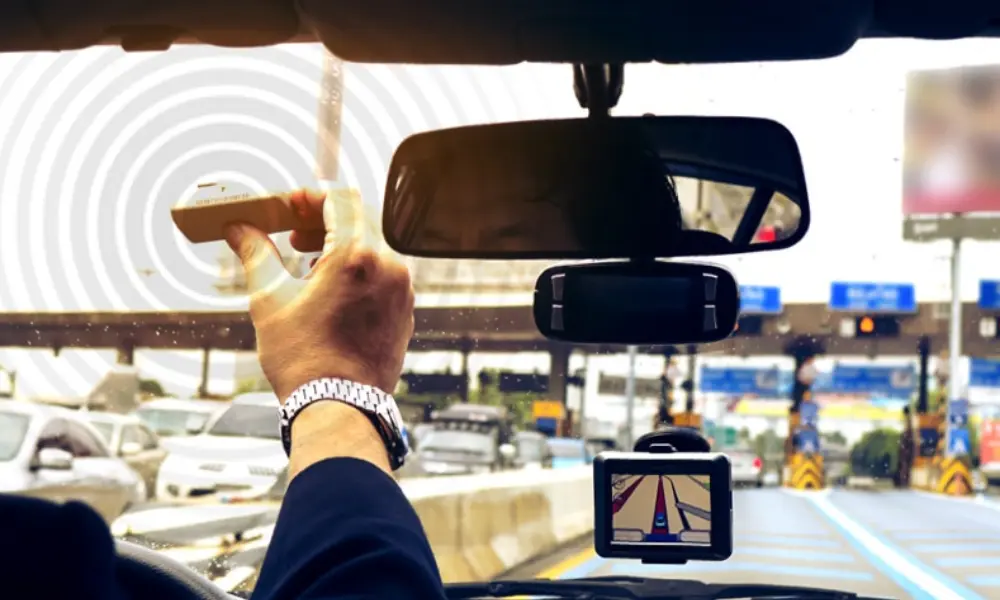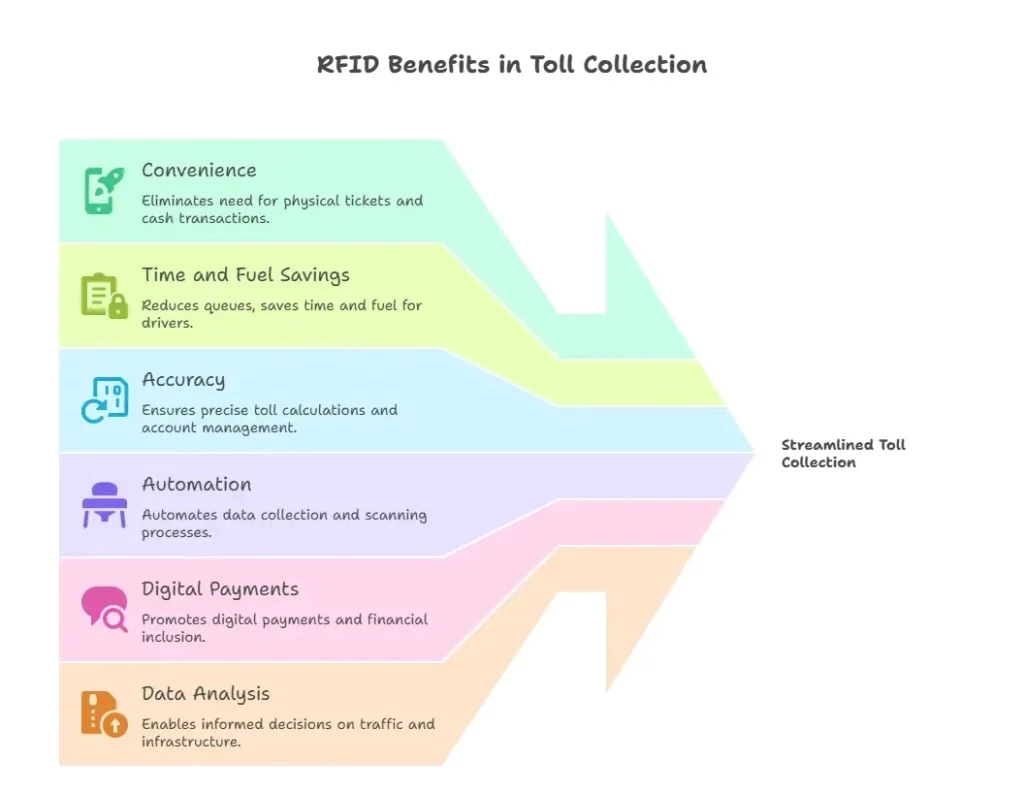RFID has become an essential part of our daily lives. This seemingly small technology has revolutionized the way we handle electronic toll payments. While RFID tags have many applications, the Fastag concept was introduced way back in 2014 to decongest long waiting lines on highways across the country.Many people are still unaware about the cashless technology. So, in this blog, we will be delving into the fundamental question: How RFID works in Fastag? Understand the details of the technology and its major benefits.
Let’s get started with understanding the meaning of an RFID tag.

What is an RFID Tag?
RFID tags or RFID full form – radio frequency identification is a tracking system used for identifying animals, vehicles, inventory, or individuals. It consists of a microchip and an antenna that uses radio waves to transmit and store information electronically. ( Think of a barcode tag.)
Each tag consists of an electronic code for unique product identification. The radio waves transfer data from the tag to the reader. The reader sends the final information to a computer program. How RFid works in Fastag depends on the key components of a tag that are listed below:
1. Tag
The tag consists of a microchip embedded inside it. It stores the information or other data specific to the application. All the processing is done via the microchip or integrated circuit.
2. Antenna
The antenna is responsible for the transmission of audio signals. When the reader sends out the information, it is captured by the antenna to power the microchip. The chip responds by sending the data back to the reader.
3. Frequency
The technology is dependent on various frequency angles. Each tag has its own frequency. The three main angles are Low, High, and Ultra High. How RFID works in Fastag varies on the basis of levels of requirement.
4. Read Range
The read range depends on whether the tag is active or passive. Active tags have a long range while passive tags have a shorter reading range. You also need to take into account environmental factors and frequency variables.
Now, that all the basics are sorted, let’s move to the inner mechanism of How RFID works in Fastag.
How RFID works in Fastag?
Fastag has been introduced to make highway toll payments efficient, fast, and hassle-free. The seamless experience allows for automated toll collection. Here is a detailed guide on how RFID works in Fastag.
1. Set Up Your Fastag Account
Vehicle owners need to create a digital Fastag account with an authorized bank or agency. Fill in all the necessary details like vehicle number and contact information. Upload all the important documents. After the registration process is complete, you will receive an RFID sticker/tag.
2. RFID Tag Attachment
The tag consists of a sticker with an integrated chip and an antenna. You need to stick it to your vehicle’s windshield. How RFID works in Fastag depends on the specified location for complete transparency and quick readability.
3. The Technology
The tag has a unique 13-digit electronic code associated with the vehicle and the owner’s Fastag account. The technology is passive as it doesn’t emit power on its own. The sticker relies completely on the energy transmitted by RFID readers at toll booths.
4. Toll Booth Readers
The readers are installed at highway toll booths across the country. It is installed above the lanes. Whenever any vehicle enters the toll booth, the reader sends out a radio signal.
5. Tag Interaction
When an RFID-tagged vehicle passes through the booth, the reader interacts with the tag on the windshield of the car. The radio waves power the tag attached to your vehicle. The interaction is the most important step in How RFID works in Fastag.
6. Data Transmission
The tag gets charged and sends the unique number to the reader. The RFID reader then transmits the number to the booth’s central server system. The server identifies the number and the related Fastag account of the vehicle owner.
7. Payment Processing
Based on the account number, the server calculates the toll amount based on the total distance traveled and the booth location. It automatically deducts the requisite balance from your account.
8. Payment Confirmation
Once the payment is debited, the gate raises automatically allowing the vehicle to pass through without stopping mid-way. The record of the transaction including the date, time, location, and amount is stored in the Fastag account.
9. Account Recharge
You need to ensure there is sufficient balance in your Fastag account to cover all the toll charges. If the amount falls below a certain threshold, you need to recharge or top up the balance through mobile apps, online banking, or recharge centers.
As a result, RFID has been instrumental in making toll payments fast and effective. Now that you are clear on How RFid works in Fastag, Let’s dive into the benefits below.
Benefits of RFID in Fastag
There are plenty of benefits of fastag RFID technology in highway toll collection. It plays an important role in streamlining vehicle traffic and toll payments. That being said, take a look at the top benefits of RFID:

1. Convenience
Fastag has notably eliminated the need for physical toll tickets, cash transactions, or, manual booth stops. Vehicle owners can enjoy a seamless experience with automatic deduction of toll charges.
2. Saves Time and Fuel
Long queues and slow-moving vehicle lines are a thing of the past. Drivers can save time and reach their destinations on time. Additionally, fuel consumption is less which helps in reducing carbon emissions.
3. Greater Toll Accuracy
Decoding How RFID works in Fastag reduces the chances of human errors. The amount is calculated based on the specific toll location and the actual distance traveled. Since the process is done online, there is no mismatch in account management.
4. No Human Interference
The RFID tag in carsThe whole process is automatic right from data collection to scanning and logging, there is no need for human intervention.
5. Automatic Account Management
Vehicle owners can directly track their Fastag account online through mobile apps. The transaction history and account balance are displayed in a user-friendly interface. Moreover, with real-time notifications and alerts, you can check your account activity easily ensuring full transparency.
6. Less Reliance on Cash Transactions
There is no manual cash handling at the toll booths. This reduces the chances of risk of theft and embezzlement thereby making toll collection secure and fast.
7. Large-Scale Acceptance
RFID has been adopted across the country. Due to large-scale implementation, it is easier to pay for long-distance travel on Indian highways. Right from private vehicles to large trucks, all can use the facility of RFID easily.
8. Digital Payment and Security
The government is actively promoting digital payments. In lieu of the recent initiatives, Fastag can encourage people to adopt digital payment methods. This will promote better financial inclusion and make India a cashless economy.
Furthermore, the tags are tamper-evident. Unauthorized individuals cannot remove the tag without damaging it. Plus, it’s difficult to counterfeit the technology.
9. Data Tracking and Analysis
A lot of data is captured online on a daily basis. Authorities can use the data to make informed decisions regarding traffic management, planning, road infrastructure, and maintenance. Real-time analysis and planning become a hassle-free task.
10. Efficient Toll Booth Management
It becomes easier for booth operators to tackle day-to-day operations due to less congestion and streamlined services. They can focus on monitoring and maintenance rather than cash management.
While RFID tags have enhanced the toll payment process, there are other uses of the technology as well.
RFID Tags- Applications
Now, that you know How RFID works in Fastag and its benefits, it’s time to look at its other uses. Some of them are listed below:
- Healthcare – The tags or wristbands are used for patient identification, tracking, medical equipment management, and surgical instrument monitoring.
- Retail– It is used for managing out-of-stock situations and replenishment. The tags prevent cases of theft and shoplifting. Plus, the tags are used for monitoring the freshness and expiry dates of perishable products.
- Security- The tags are used in luggage and baggage tracking, authentication, document security, and employee identification.
- Logistics – It helps in tracking inventory and supply chain management.
Moving on, it’s time to tackle the most frequently asked questions about RFID technology.
CONCLUSION
To sum it up, the inner structure of How RFID works in Fastag depends on the reader, the microchip, and the associated tag. We can conclude that implementing RFID has been revolutionary in changing the toll payment landscape in India.
Enhance your RFID experience with Qodenext. Reach out to us if you want to understand the process of RFID technology better.
FAQS- HOW RFID Works in Fastag
1. What is the difference between RFID and Fastag?
RFID and Fastag are two broad terms used for the same technology. RFID tags are stickers on a car’s windshield to enable automated toll collection. The reloadable tag uses the RFID technology once the tag account is activated.
2. What is the range of the Fastag sensor?
How RFID works in Fastag is when a vehicle comes within 20 to 30 feet of the range of the reader, the tag gets activated and the toll payment is initiated.
3. What if the Fastag sticker is damaged?
You must raise a replacement request with the issuing bank at various applicable charges. Deepening on the damage, you can ask for a new tag.
4. Can I use Fastag in another car?
The tag is vehicle-specific and cannot be transferred to another car. Fastag will stop working if you remove the sticker as the circuit gets damaged inside. This will be an obstacle to the proper functioning of How RFID works in Fastag.
5. On which technology does FASTag work?
FASTag works on Radio Frequency Identification (RFID) technology. This allows automatic toll payment when the tag is scanned at toll plazas without stopping the vehicle.
6.Which sensor is used in FASTag?
FASTag uses an RFID sensor that communicates with the tag attached to the vehicle’s windshield. This sensor reads the stored information and deducts the toll amount directly from the linked account.
7.What technology is used in SBI FASTag to read the tag?
SBI FASTag, like all FASTags, uses RFID-based technology. RFID readers installed at toll plazas detect the tag, validate the account details, and enable a cashless toll transaction.
8.How does FASTag get scanned?
FASTag gets scanned when the RFID reader at the toll plaza sends out radio signals that activate the FASTag sticker on the vehicle. The tag transmits the vehicle and account details back to the system, and the toll fee is deducted automatically.






